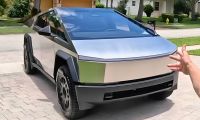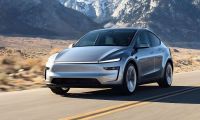When you think of robots, visions of robot guard dogs often flash through your mind – or on a screen. You would never think that robots may one day help folks charge their electric vehicles. That, though, is the aim of a new plan unveiled recently by Ford, which has developed a prototype robot charging station that drivers operate using their smartphones from inside their electric vehicles.
Indeed, says the automaker, filling a car with fuel or charging an electric vehicle is a simple task for most of us. But for disabled drivers, people with reduced mobility, and those who are older, refueling or recharging can be a significant challenge.
Ford Seeking A Robotic Solution
Having identified the challenge facing many drivers, the automaker is, as noted, working on a robotic solution. Ford is testing the robot charging station as part of a research project to develop hands-free charging solutions for electric vehicles and fully automatic charging for autonomous vehicles.
Angela Aben, Employee Communications, Ford of Europe, who uses a power-assisted wheelchair to gain more mobility and independence, said, "I stopped filling up my car myself years ago because it became very strenuous. My husband does it for me. The introduction of a robot charging station would offer me a much greater level of independence."
Following initial lab testing, Ford researchers are now putting the robot charging station to the test in real-life situations. Once activated, the station cover slides open, and the charging arm extends towards the inlet with the help of a tiny camera. For the trial, drivers could monitor the charge status via the FordPass app. After charging, the arm retracts back into place.
Robot Station Could Be Installed In Disabled Spaces
The robot charging station, custom-made by Dortmund University in Germany, could be installed in accessible parking spaces, car parks, or private homes. Further applications could include fast and efficient charging of company fleets. The technology could also support more powerful charging to charge vehicles in a much shorter time.
"Ford is committed to ensuring freedom of movement, and right now, refueling or charging your vehicle can be a major problem for some drivers. The robot charging station could be an added convenience for some people but – absolutely essential for others," said Birger Fricke, research engineer, Research and Innovation Center, Ford of Europe.
The process could become fully automated, with minimal or no driver involvement. The driver would send the vehicle to the charging station, with the infrastructure ensuring it reaches and returns from its destination autonomously.
On the road to electrification
This research project complements Ford's commitment to electrification. A follow-up project with the charging network provider IONITY will look to further improve the robot charging station.
Ford is also researching robot charging solutions in combination with Automated Valet Parking, as demonstrated at IAA in Munich, Germany, last year.
Ford's fast-growing Blue Oval Charging Network provides customers with access to a network of over 300,000 chargers across Europe. To help drivers find charging stations and pay for charging, Ford Charge Assist can be accessed using the touchscreen of Ford's SYNC 4 connectivity and entertainment system.
For commercial vehicle customers, Ford Pro Charging offers bespoke charging solutions incorporating charging equipment, ongoing maintenance, and management software that help reduce time-consuming paperwork and charge schedule planning.
Ford recently joined 27 companies in a petition to ensure all new cars and vans in Europe are zero-emission from 2035 and called for targets to grow electric vehicle charging infrastructure in Europe to keep pace with electric vehicle growth rates.
Unified Approach Being Taken
The company believes a unified approach encompassing governments, European Union institutions, the entire auto industry, energy providers, local authorities, and consumers is required to accelerate the development of a comprehensive, easily accessible, and efficient charging infrastructure at home, in the workplace, and in public locations.
Marc Stern has been an automotive writer since 1971 when an otherwise normal news editor said, "You're our new car editor," and dumped about 27 pounds of auto stuff on my desk. I was in heaven as I have been a gearhead from my early days. As a teen, I spent the usual number of misspent hours hanging out at gas stations Shell and Texaco (a big thing in my youth) and working on cars. From there on, it was a straight line to my first column for the paper, "You Auto Know," an enterprise I handled faithfully for 32 years. Not many people know that I also handled computer documentation for a good part of my living while writing YAN. My best writing, though, was always in cars. My work has appeared in Popular Mechanics, Mechanix Illustrated, AutoWeek, SuperStock, Trailer Life, Old Cars Weekly, Special Interest Autos, etc. You can follow me on: Twitter or Facebook.












